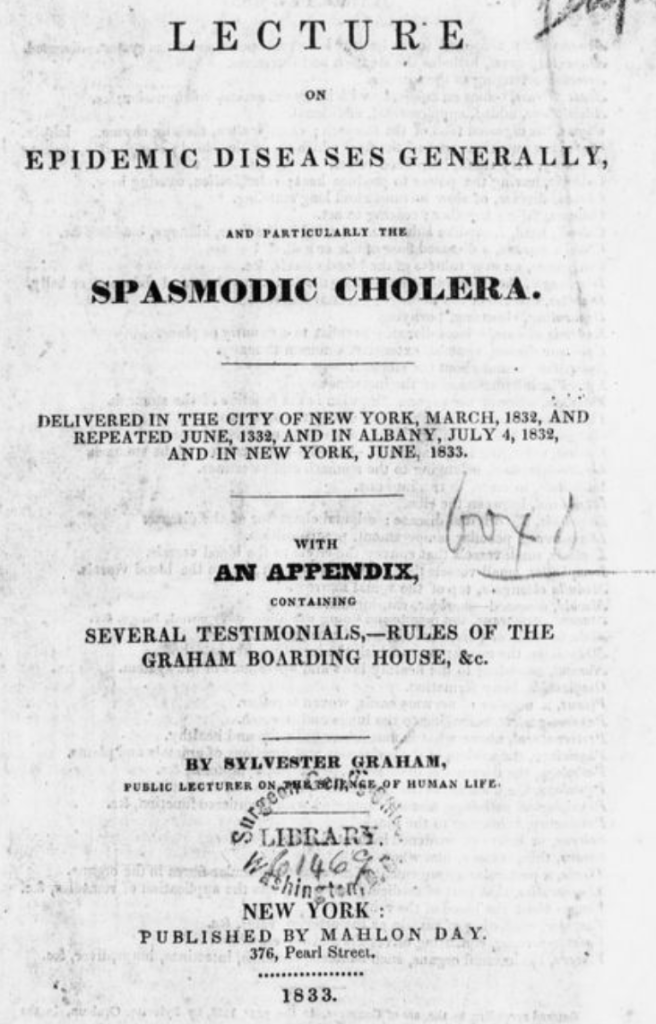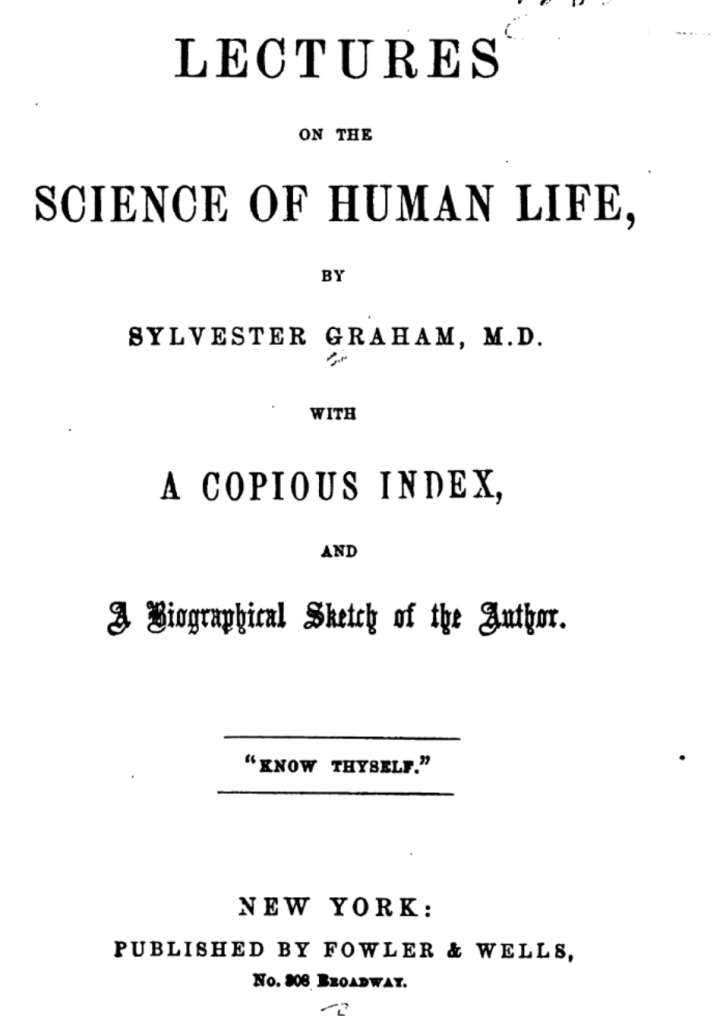Timeline
1794: Born July 5th, 1794. He was the youngest of 17 children and was a delicate child. His father died when Graham was two, and his mother had an illness at the time. He spent his childhood moving from one relative’s home to another. One of his relatives ran a tavern where Graham was put to work. His experience with drunkenness and its impact on one’s health led him to despise alcohol. He was the exception to the rule, as, during this time, everyone drank.
1810: At the age of sixteen, he was thought to have “contracted consumption.” He was sent into the country and was a clerk in a country store in New York. He points out that his reformed diet and his hygienic mode of life enabled him to remain alive and in active health as long as he did.
1823: Graham entered Amherst College and proved himself a gifted orator.
1826: Married Sarah Manchester Earle (27 February 1799 to 7 January 1868.) The couple had two children: Sarah (born c. 1828) and Henry Earle (18 October 1833 to 18 November 1873). He joined the Presbyterian church and became a preacher. During this time, he studied anatomy, physiology, and general health, culminating in his ultimate emergence as a great health teacher, he wrote a book on “Chastity” and began his interest in moral and social reform and a book entitled “An Apology,” a reply to critics who pointed to his frail constitution as a refutation of his teachings as well as wrote many articles for magazines.

The bread was made precisely,
as described in his Treatise on Bread and Bread-Making.
1829: Sylvester Graham invented the Graham cracker, introducing the world’s first graham product. It was a dull, unsifted flour biscuit. Graham influenced other Americans, including John Harvey Kellogg, founder of the Battle Creek Sanitarium.
1830: He left the church and worked with the Pennsylvania Temperance Society. He expanded his belief that drinking was physically unhealthy, and he included foods and non-alcoholic beverages that should be avoided. During this time, Graham began to advocate fasting. Frequent references to fasting can be found in the Graham Journal of Health and Longevity during the three years of its publication (1837-39), and many benefits were described as flowing from the practice. Graham is quoted in The Greatest Health Discovery, “Fasting removes those substances which are of the least use to the economy, and hence, all morbid accumulations, such as wens, tumors, abscesses and so on, are rapidly diminished and wholly removed by abstinence and fasting.”
1830: The crusade for “health and physiological reform” was launched by Sylvester Graham through his lectures and writings. He became a champion of Natural Hygiene and living reform. He boldly asserted that right living is a more specific means to health than a resort to physicians and drugs. He lived in Rochester and lectured in Providence, Buffalo, and many other cities. Rochester was small, and people had to travel by buggy or on foot. He attracted an audience of three thousand people in that city and soon had a significant following.
1830-1840: Graham Temperance Houses often operated as small hotels in New York City, Boston, and Rochester. The focus was on Graham’s living system, diet, daily cold showers, and sleeping on straw mattresses rather than feather beds. Meals – consisting of no more than three items — were to be eaten six hours apart at precisely the same time every day.

1833: Published A Lecture on Epidemic Diseases Generally, and Particularly the Spasmodic Cholera. In this lecture, he connects all the nerves of organic life and shares how they are woven together. It is through these connections that food is transformed into energy. He knows that when the function of digestion is healthy, man has the greatest physical power for achievement and endurance and the ability to resist the influence of cold, heat, wet, dry, or any infectious diseases.
1837: A group of Graham’s students founded the world’s first physiological society (The American Physiological Society) in Boston to promote Grahamism. William Alcott was the first President of the Society. After a year, the Society was reported to have 251 members. It lasted just three years.
1837: Published Treatise on Bread and Bread-Making. Graham starts with the history of bread, beginning with the Greeks and Romans, and dives into the laws of diet and why food should be as close to its natural state as possible. He goes into the bread materials and how they should be kept whole and not separate out any of the nutrient particles.
1837: Published Lectures On the Science of Human Life. Considering that it was written over 150 years ago, it is remarkable and a veritable classic on the subject. This text covered practically the entire field of the hygienic reform movement, diving into anatomy, physiology, mortality, regularity in eating, thorough mastication, hygienic cookery, quantity and quality of food, fasting, sleep, air, bathing, and exercise.
1837: Graham and David Cambell founded The Graham Journal of Health and Longevity. It was “designed to illustrate by facts and sustain by reason and principles the science of human life as taught by Sylvester Graham.

1843: A sample Graham diet advertised in the New York Tribune:
- Monday – Pea soup, vegetables, fruit, and plum pudding.
- Tuesday – Baked peas, vegetables, fruit, and apple custard.
- Wednesday – Vegetable soup, rice, and prune pie.
- Thursday – Vegetables, boiled bread pudding, cream and fruit.
- Friday – Vegetables, fruit, pumpkin or potato pie.
- Saturday – Bean soup, vegetables, rice, or sweet potato custard.
- Sunday – Baked beans, Yankee bread, cream pie, and fruit.
Sylvester Graham is generally considered the founder of the National Hygiene movement. He was America’s first crusader for healthful living.
1850: William Alcott, William Metcalfe (pastor of the Bible-Christian Church, founded 1817 in Philadelphia), Russell Thacker Trall, and Sylvester Graham united to create the American Vegetarian Society (AVS). Following a founding convention in New York City, the society’s first official meeting occurred in Philadelphia’s Bible-Christian Church on September 4, 1850. The first meeting would also elect Dr. William Alcott as the AVS president, a title held until his death in 1859. Metcalfe and Graham were elected vice presidents, and Trall was the recording secretary. The society promoted vegetarian precepts (then intertwined with pacifism, women’s suffrage, and the abolition of slavery) across the nation. By the time of the Civil War, the group’s membership and influence waned, partially because the fight for abolition had turned to military violence.
1851: Sylvester Graham died at age 58 on September 6, 1851.


 SUBSCRIBE TODAY AND NEVER MISS AN UPDATE
SUBSCRIBE TODAY AND NEVER MISS AN UPDATE